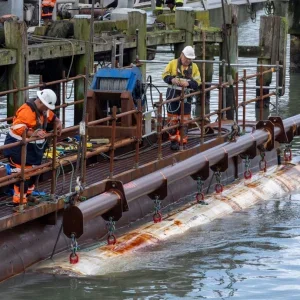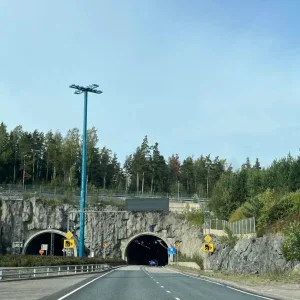"We cannot guarantee that no more sinkholes will appear but we have several teams, comprising public utilities companies and traffic police on standby if another sinkhole appears," he said.
He said sinkholes had emerged as the ground underneath was the meeting point between two types of soil.
"The Bukit Bintang area is very unique geologically as it is the meeting point of the Kenny Hill and Caustic Limestone formation. The different geological conditions and soil densities made it challenging for our TBM," Azhar said during a press conference at the company’s headquarters in Menara I&P, Jalan Dungun, Kuala Lumpur, on 29 May.
He assured the public that all safety measures had been taken following the emergence of three sinkholes and a major water pipe burst over the past several weeks.
The first sinkhole appeared on 23 April opposite the LTAT building. The next sinkhole appeared on 26 April near Menara Worldwide and caused water pipes to burst. A third sinkhole appeared on 6 May in front of the Audi showroom.
Azhar said despite the use of surveillance equipment to detect any abnormal soil movement, there were various cavities that were either hollow, filled with water or loose soil, which could result in erosion when the TBM drilled past.
Separately, according to a report on the construction status of the Klang Valley Mass Rapid Transit (KVMRT) Sungai Buloh-Kajang (SBK) Line published in late-May 2014, the overall completion of the SBK Line is now at 43.49 per cent, placing the project ahead of schedule. On the other hand, tunnelling works for the 9.5km underground alignment are now more than half finished at 56 per cent.
In the next few months, it is anticipated that progress of SBK Line’s structural works will be in its busiest pace, paving the way for the commencement of interior fit outs and systems works in the coming years.
Besides construction of piers and station portals, as well as lifting of segmental box girders that make up the elevated guideway along the elevated sections of the SBK Line, the underground segment running from Semantan towards Maluri is also fast taking shape.
"For underground works, we are now casting the superstructures of the multi-storey stations such as the station box and floor slabs. In terms of tunnelling, we have finished excavating 90 per cent of the 7.5km high-risk karstic limestone geological formation of the underground alignment.
"One of the Variable Density TBMs is expected to finish the karstic limestone section by the end of July. When both TBMs have entered the ‘safe zone’ of the Kenny Hill formation, we will be safely on track to complete all tunnelling works by mid-2015," said MMC-Gamuda general manager for underground works, Ubull Din Om.
Of the 10 TBM drives, four are already completed and are being dismantled for refurbishment and reuse for other metro tunnels.
Five other TBMS are still in the ground, with two tunnelling at Jalan Bukit Bintang towards the Bukit Bintang MRT station, two from KL Sentral MRT station towards Pasar Seni, and one from the Pudu Launch Shaft towards Merdeka. The last TBM will be launched to tunnel from the Pudu Launch Shaft towards Merdeka.
The next two months will be most critical for the underground works contractor as it needs to tunnel past the last 10 per cent of the karstic limestone formation of the underground alignment. The challenge is to build two stacked large diameter tunnels (with an external diameter of 6.67m) across the undulating karst that is layered with the material of the Kenny Hill formation, without disturbing the fragile soil equilibrium.
"Ground condition at the interface location, which extends from the LTAT building towards the Pavilion shopping mall, under Jalan Bukit Bintang, proves to be riddled with karstic, fractured and contains cavities of mostly non-cohesive, silty top soil that is easily mobilised into movement even by slight changes of groundwater heads. The series of faults at this vicinity also result in blocky ground, which poses difficulties to the tunnelling works.
"We are on high alert 24/7 to monitor the situation and will deploy our emergency team if an incident happens," said Ubull, adding that healthy progress is made despite the huge challenge faced and thanked all parties involved who have helped ensure the tunnelling process progresses smoothly.
Aside from the geological aspect, tunnelling underneath live traffic in Bukit Bintang is also demanding in terms of public safety as it is one of the top tourist hotspots in the heart of Kuala Lumpur, and it is surrounded by numerous office buildings, luxury hotels, age-old shoplots and high-end shopping complexes.
To ensure high responsiveness to untoward incidents, hundreds of automated settlement markers and monitoring equipment are installed at buildings located within the ‘zone of influence’ to help surveyors determine the level of settlement that has taken place or changes in soil movement.
"With this information, we have been able to safeguard stakeholders’ safety, while at the same time tunnel effectively. Our surveillance personnel are on ground to observe abnormal changes to ground level, such as roads and pavements at all times. We are pleased that no major incidents have taken place thus far," said Ubull, adding that where settlement was detected, best practices in safety and remedial measures were implemented, which include temporary closure of lanes and ground treatment (grouting) to stabilise the ground.
"Despite the use of the latest building protection equipment, the most advanced TBM and the most comprehensive project management expertise, Bukit Bintang remains a daunting stretch to tackle. We look forward to completing this vital stretch as uneventful as possible," Ubull said.







